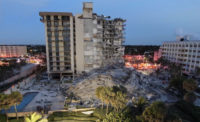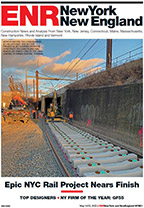Implosion of Quake-Damaged Building in New Zealand May Pave the Way for Other Controlled Demolitions
Despite many challenges, Controlled Demolition Inc. successfully led the razing, using explosives, of the 14-story Radio Network House in Christchurch, which was damaged in the 2011 New Zealand earthquake. The Aug. 5 implosion may open the door to other controlled demolitions in New Zealand, says CDI.
“The structure did exactly what CDI said it would, in spite of the extraordinarily heavy rebar in the 1986 [structure] that was built to what was already a rigorous seismic code,” says J. Mark Loizeaux, CDI’s president.
He adds that dealing with the concrete structure's reinforcing steel, the area's poor soil conditions and the limited selection of low-energy and low-velocity explosives available in New Zealand were the job's greatest challenges.
The building came down in seven seconds after a week of preparation. Workers placed 47 kg of explosives into 141 holes drilled on levels of the building.
No debris flew outside of the at-source protection placed within and around the structure, says CDI. There was also no damage to adjacent structures, including a two-story building located less than 35 ft away.
CDI and its team managed to avoid damaging underground utilities, which was a major concern to government authorities. “Vibration generated was very low, says Loizeaux.
The key task remaining is to compare actual vibration readings, taken from soil that has been called “the worst” in Christchurch” to see if CDI’s computer were able to accurately predict vibration at various distances to adjacent properties. The models are based CDI’s implosion database of similar structures and soil conditions.
If the real data lines up with the models, it is likely that the Canterbury Earthquake Recovery Authority will accept requests to use controlled demolition on other damaged properties, rather than razing using slower, more conventional methods, says Loizeaux.






